| Sword of Israel:
Egyptian Pieces, Part Four
By Mike Bennighof, Ph.D.
April 2023
 By the early 1960’s, Egypt’s armor had been surpassed by new Israeli acquisitions, as the IDF built up its tank arm with cutting-edge American-made M48 Pattons and British-built Centurions. The weapons of the Great Patriotic War, even when built by Czech craftsman and modernized, could not match the new tanks even as the United States rebuffed Israel efforts to buy its most modern tank, the M60. By the early 1960’s, Egypt’s armor had been surpassed by new Israeli acquisitions, as the IDF built up its tank arm with cutting-edge American-made M48 Pattons and British-built Centurions. The weapons of the Great Patriotic War, even when built by Czech craftsman and modernized, could not match the new tanks even as the United States rebuffed Israel efforts to buy its most modern tank, the M60.
Let’s have a look at some of Egypt’s most effective weapons, as seen in Panzer Grenadier (Modern): 1967: Sword of Israel.
Britain’s Cutting Edge
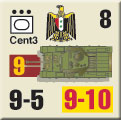
Egypt was the first foreign customer (outside the Commonwealth) allowed to purchase the Centurion tank, ordering 64 of them in 1949 (some sources put the number ordered at 80). About half of them had been delivered when the Western nations began to enforce a policy of selling arms only to Middle Eastern nations that joined a security pact. The royal government refused to do so, considering it a neo-colonial infringement of Egyptian sovereignty, and insisted that the British withdraw from the Suez Canal zone as well. The British refused to deliver the rest of the tanks.
Those Egyptian Centurions actually delivered came straight from the factory in 1950, new Mark III tanks armed with a 20-pounder (84mm) main gun and a co-axial Polsten 20mm automatic cannon. The Egyptian tanks never received the upgrades to the awesome Royal Ordnance L7 105mm that armed Israeli Centurions in 1967.
All 29 of the operational Egyptian Centurions were in Sinai in June 1967 where all were lost, some of them knocked out by the superior guns of Israeli Centurions. Several were repaired, upgraded and put into Israeli service (the number is unclear, as the Israelis also captured Jordanian Centurions).
Cold Warriors
 
Egypt had attempted to purchase modern weapons from the West, but when the British, French and Americans all turned away their piastres President Gamel Nasser turned to the Soviet Union, who in turn passed him on to their Czech allies. That fruitful relationship had brought the Egyptians their T-34/85 and SU100 vehicles, and when Nasser sought tanks to match the first-rate Israeli tanks the Czechs once again provided.
As in the 1955 deal, the Soviets guaranteed payment but the Egyptians forged the purchase directly with the Czechs. They bought 350 T-54 tanks in 1960, and another 150 of the improved T-55 in 1963. More of both models were ordered in 1967, but did not arrive in time for use in the Six-Day War. Just like the previous deal, the Egyptians paid 80 percent of the purchase price in cotton, and the remainder in hard currency. The last of the T-54’s arrived in 1966, and the T-55 order had been completed before the war began.
As with the T-34/85 tanks, the Czech factories turned out higher-quality machines than the Soviet-made tanks provided to Syria. The T-54 was the first Soviet-designed tank with night-fighting capabilities, and the Egyptians upgraded at least a few of their machines with British-made licensed copies of the American Starlight night-vision scope.
The T-54 had begun as a replacement for the T-44 medium tank, itself a replacement for the T-34/85, but by the time its lengthy development process concluded it bore little resemble to the Hammer of the Proletariat. It had the “inverted-frying-pan” turret common to post-war Soviet tank design, with a powerful 100mm gun that could be accurately fired on the move, excellent armor protection and a reliable engine and drive train.
The T-54 had its flaws: it was such a small tank that most armies that operated it felt forced to recruit short crewmen. The gun couldn’t be depressed very far, and this made it difficult to deploy the tank in a hull-down position.
The T-55 boasted a number of improvements, starting with survivability in a nuclear-biological-chemical environment. It had an improved loading mechanism for the main gun and wet stowage for its ammunition, a better-protected turret and a new diesel engine. The Soviets modified most of their own T-54 tanks to T-55 standards but it doesn’t appear that the Egyptians had done so by the time of the 1967 war. Afterwards they carried out a major program of modifications, culminating in the Ramses upgrade introduced in the early years of the new century (but apparently not widely adopted).
Armoring the Infantry
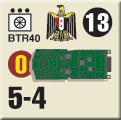 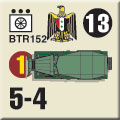 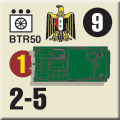 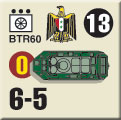
The 1956 Czech arms deal included 220 BTR-152 armored personnel carriers, the Soviet equivalent to the American M3 halftrack except rolling on six wheels instead of tank-like treads. The BTR-152 took the chassis of a ZiS-151 heavy truck and added an armored body and a more powerful engine to compensate for the increased weight. The Egyptians also fielded a number of BTR-40 carriers, the smaller predecessor to the BTR-152 with only four wheels instead of six.
The Egyptians could not afford as many Soviet and Czech weapons as they desired, despite a substantial discount (30 percent off list price, just like a Gold Club member) and easy credit (two percent annual interest) and payment (cotton was accepted in lieu of cash) terms. Nasser also hoped to wean his country off foreign imports of industrial goods, including arms. The Kader factory, the president hoped, would become the “arsenal of the Arab world.” Other Arab states invested, and its first product would be a local copy of the BTR-40 armored personnel carrier known as the Walid. Ultimately about 1,000 of them would be built starting in 1967; it’s unclear if any of these saw action in the Six-Day War.
Along with better tanks, the Egyptians also sought more modern armored personnel carriers, and in the same agreements that brought them the T-55 they purchased the new and radically innovative BTR-60. Soviet designers drew on the Egyptian experience with the BTR-40 and BTR-152 in the 1956 war, which proved these vehicles inadequate against modern weapons, starting with their lack of overhead protection.
While the BTR-60 had been intended to allow the 14 infantrymen it carried to fight from within the vehicle, with firing ports for their personal weapons, in practice it turned out to still have some problems It caught fire easily and proved terribly vulnerable to hand-held anti-tank weapons. Only a few saw action in 1967, and the Soviets had already begun manufacture of the BMP-1, a far more effective infantry fighting vehicle.
Mobile Firepower
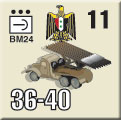 
Shortly before the outbreak of the Great Patriotic War, the Red Army developed a truck-mounted launcher for what had been the RS-132 aircraft-mounted rocket. When launched by an airplane the RS-132 was grossly inaccurate, and the new BM-13 ground-based launcher made up for that by mounting sixteen launch rails together to be loosed in a single salvo. No single rocket had to hit its target for the salvo to be devastatingly effective.
After the war, an improved launcher, the BM-24, came into use tossing a much larger rocket with a greater range and explosive warhead. The Soviets exported the launcher to their allies, including a great number of them to the Egyptians.
The Soviet Union had introduced the weapon in large part due to ease of manufacture, and that allowed the Egyptians to manufacture it using their far less advanced industrial base. The Sakr-18 launched a smaller rocket than the BM-24, but had outstanding range and remains in service, now equipped with cluster munitions rather than the simple high-explosive warheads deployed in 1967.
You can order 1967: Sword of Israel (Playbook edition) right here.
Arab-Israeli Package
1967: Sword of Israel (Playbook)
IDF: Israel Defense Forces
Voice of the Arabs
Retail Price: $147.97
Package Price: $120
Gold Club Price: $96
You can experience the Arab-Israeli Package right here.
Please allow an extra three weeks for delivery.
Sign up for our newsletter right here. Your info will never be sold or transferred; we'll just use it to update you on new games and new offers.
Mike Bennighof is president of Avalanche Press and holds a doctorate in history from Emory University. A Fulbright Scholar and NASA Journalist in Space finalist, he has published a great many books, games and articles on historical subjects; people are saying that some of them are actually good.
He lives in Birmingham, Alabama with his wife, three children, and his new puppy. He misses his Iron Dog, Leopold.
Want to keep Daily Content free of third-party ads? You can send us some love (and cash) through this link right here.
|
